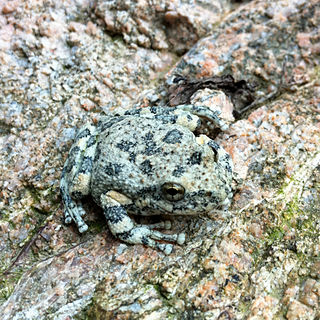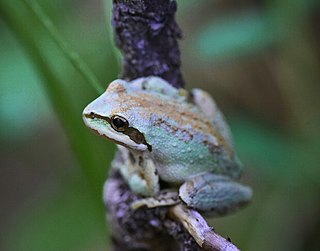
Hylidae is a wide-ranging family of frogs commonly referred to as "tree frogs and their allies". However, the hylids include a diversity of frog species, many of which do not live in trees, but are terrestrial or semiaquatic.

Pseudacris is a genus of frogs in the family Hylidae found in North America ranging from the Pacific coastline to the Atlantic.

The California tree frog or California chorus frog is a "true" tree frog from southern California (USA) and Baja California (Mexico). Until recently, the California tree frog was classified in the genus Hyla.

The Pacific tree frog, also known as the Pacific chorus frog, has a range spanning the Pacific Northwest, from Northern California, Oregon, and Washington to British Columbia in Canada and extreme southern Alaska. They live from sea level to more than 10,000 feet in many types of habitats, reproducing in aquatic settings. They occur in shades of greens or browns and can change colors over periods of hours and weeks.

The Appalachianmountain chorus frog, formerly known as just the mountain chorus frog, is a species of frog in the family Hylidae. The species is endemic to the United States. The natural habitats of P. brachyphona are temperate forests, rivers, intermittent rivers, swamps, freshwater marshes, intermittent freshwater marshes, freshwater springs, ponds, open excavations, and canals and ditches. It is threatened by habitat loss.

Hylinae is a large subfamily of "tree frogs", family Hylidae.

There are 14 species of amphibians and 5 species of reptiles known to occur in Mount Rainier National Park.

The Sierran chorus frog or Sierran treefrog has a range from the West Coast of the United States from Central California inland through Idaho. They live from sea level to more than 10,000 feet in many types of habitats, reproducing in aquatic settings. They occur in shades of greens or browns and can change colors over periods of hours and weeks.

The Baja California chorus frog is a species of treefrog of Western North America. It was formerly considered as part of the Pacific chorus frog, but was split and raised to species status in 2006. The species ranges from the West Coast of the United States from Baja California through southern California. Individuals live from sea level to more than 10,000 feet in many types of habitats, reproducing in aquatic settings. It occurs in shades of greens or browns and can change colors over periods of hours and weeks.










